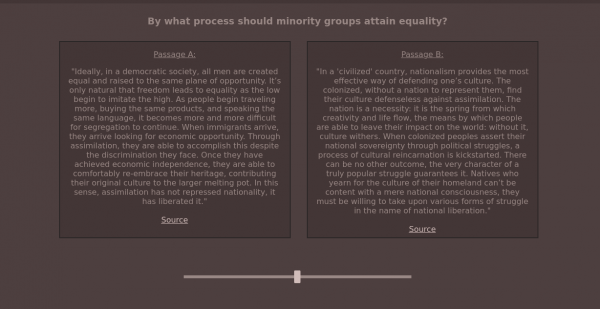*The following is part of a larger series discussing the ongoing development of PoliTree, an attempted political-compass killer which has been way too long in the making. To find out more, visit the introduction. *
Disclaimer: All sections before October 2019 were written in retrospect.
May 2018
As part of some of the changes I was rolling out to an old Discord server of mine, I had the idea of creating a test to help people choose roles. The two main differences from other tests at this point were:
- The test is integrated into the Discord server’s custom bot I made, so there’s no need for an external site.
- Instead of approximating through a score, the test was purely operating on Boolean logic in an attempt to guess someone’s beliefs through process of elimination.
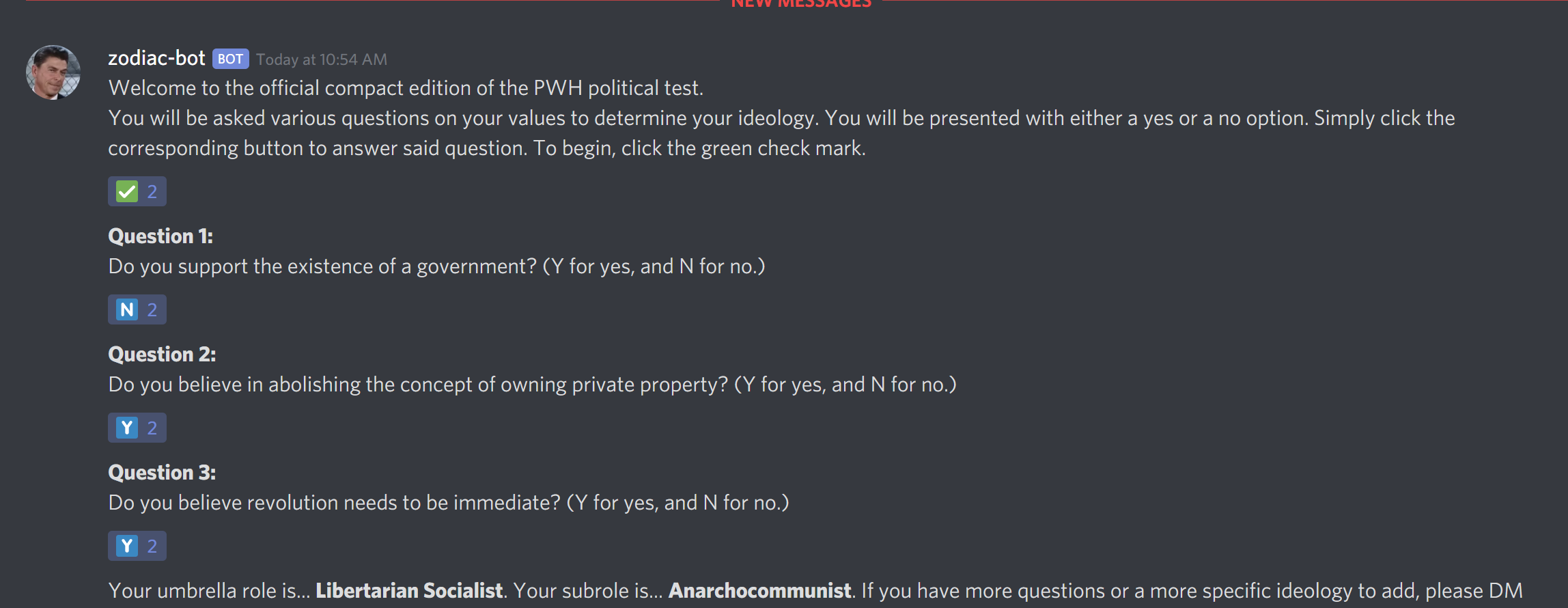
While this proved accurate for more common beliefs and had a clean front-end, behind the scenes it was scaling horribly: the amount of questions and possibilities to be accounted for grew exponentially as the scope of ideology broadened.
July 2018
Following some discussions and the retiring of the old bot, I returned to the drawing board and began drafting a chart in an attempt to categorize ideology; the main purpose at the time was to prove that a political center did not exist, and that ideology was not a left/right gradient.
I used the Political Triangle as a model, basically drawing on top of it in OneNote. As you can see, it was incredibly crude and inaccurate in a lot of places. A lot would have to be fixed, but you can begin to see concepts being ironed out such as the usage of a table before the logic gates.
Unsurprisingly, it got posted on /r/badpolitics; mocking aside, I actually did end up getting important feedback on the design from a few people in the thread.
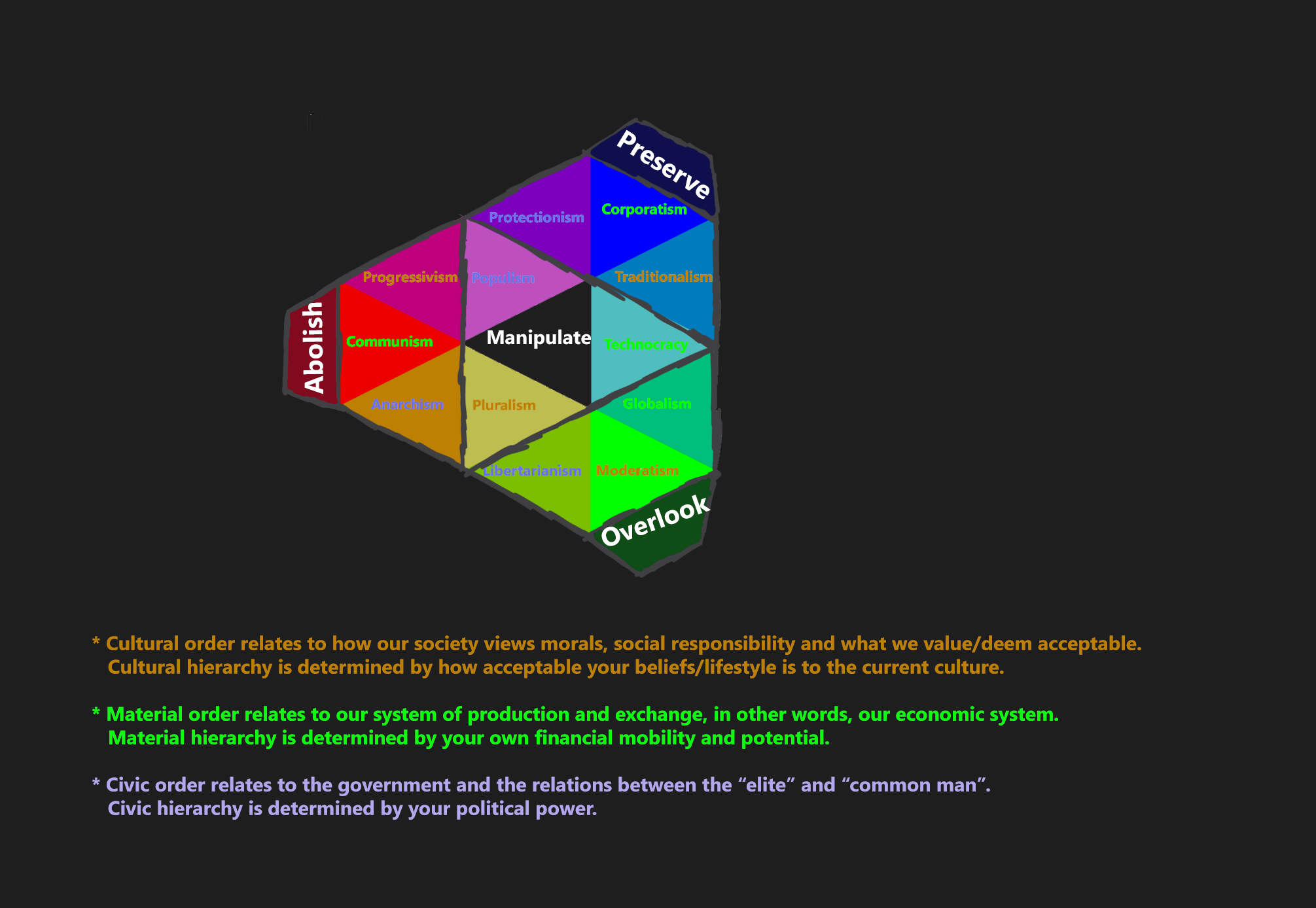
August 2018
The triangle itself was rather confusing without a proper explanation, and up until this point I had simply gave the explanation on the spot whenever I posted it; I felt it was more efficient and sensible to bundle the explanation with it onto a “poster” of sorts. It came with a warning and a guide to what each of the various colors represented.
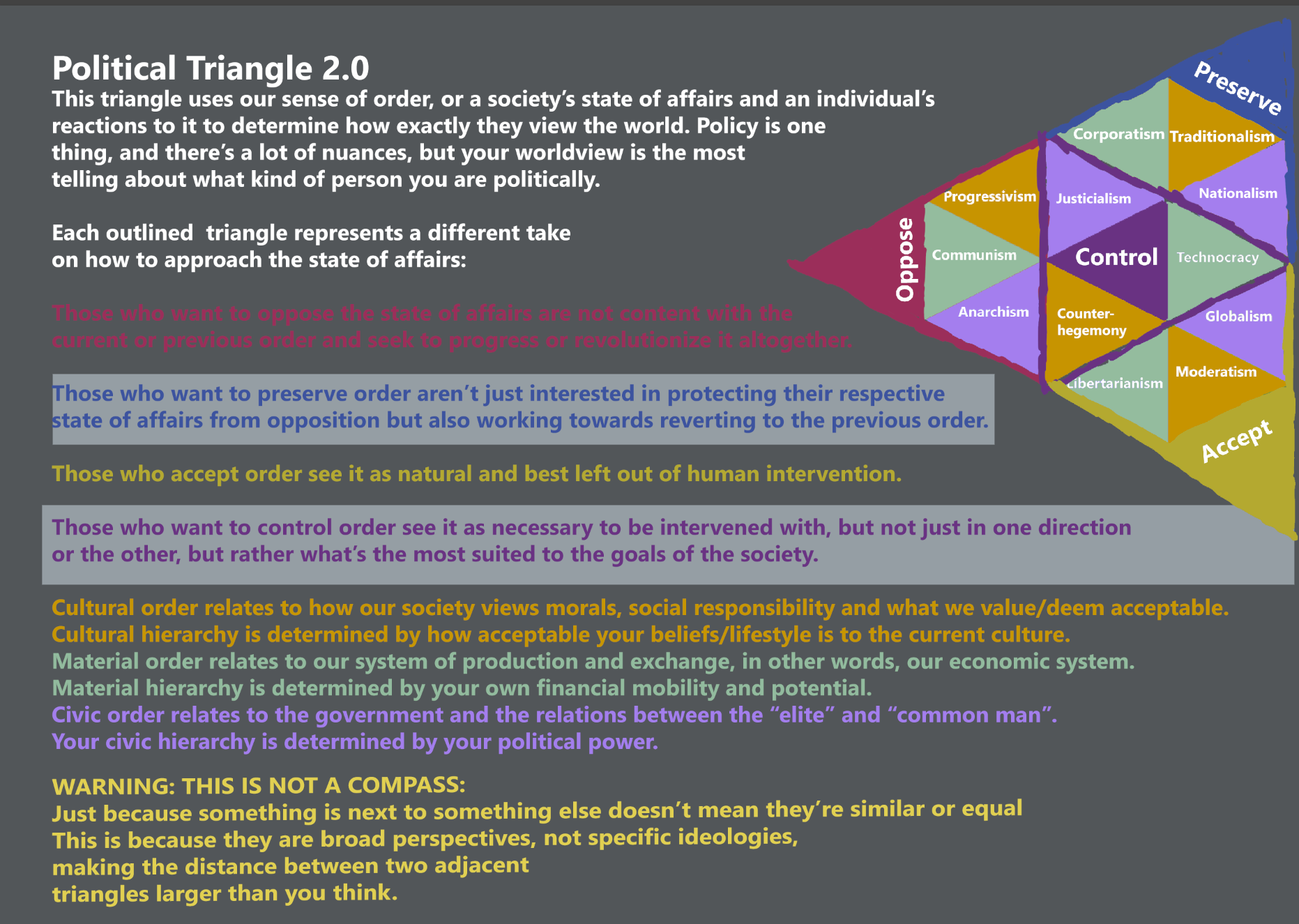
October 2018
The chart design badly needed an update, not just due to how ungodly ugly it was, but also because making changes was difficult when all the layers get merged on a standard image.
So I decided to sit down and remake the chart from scratch, but as an SVG this time. This would allow me to change colors, text, and positioning easily without affecting the rest of the image. This ended up being a good move, because over the next few months, the chart would go through countless minor revisions here and there.
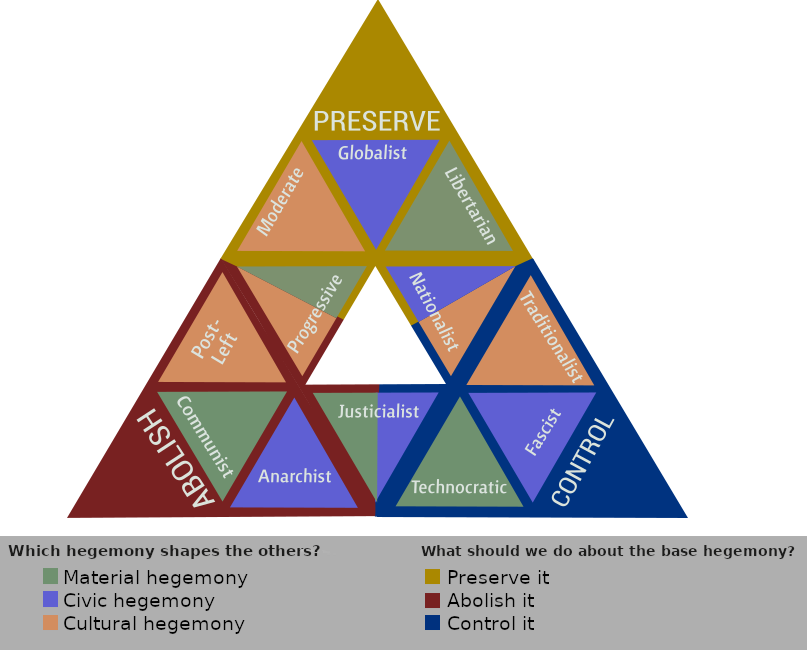
November 2018
I concluded my design was too complex for solely a chart, not just in a matter of execution, but also due to the nature of the topic itself. Too simple and it becomes just as inaccurate as the other charts I intended to replace, too dense and it’s incomprehensible.
So, a new idea came to me: the other charts are known to use websites which are able to set up a test of sorts to walk people through the process. With a test I’d be able to convey these concepts without overwhelming the user with the information density.
At this point in time, I had no idea what I wanted the site to look like, so I focused on the more mechanical parts of the test with minimal CSS.


I settled on a model that fused the table-chart with the flowchart questions of May’s design. The chart would narrow down the person to a specific “leaf” or sector of ideology, and then the flowchart would narrow it down to something specific.
In order to do this, I drafted a list of final results, or “branches”, and began making questions to bridge the leaf to the branch.
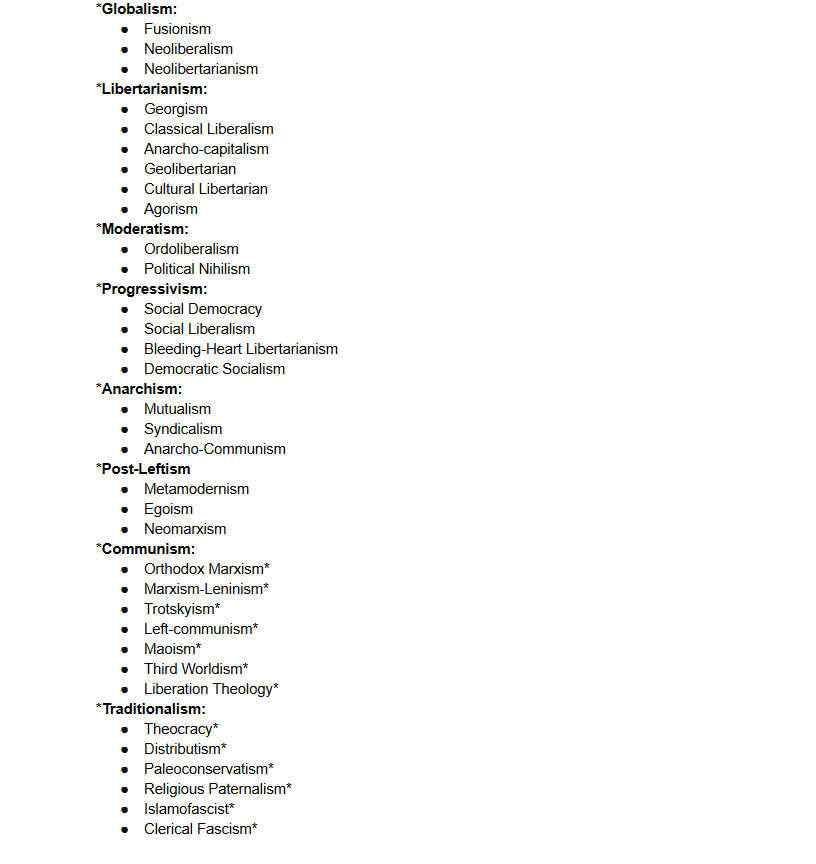
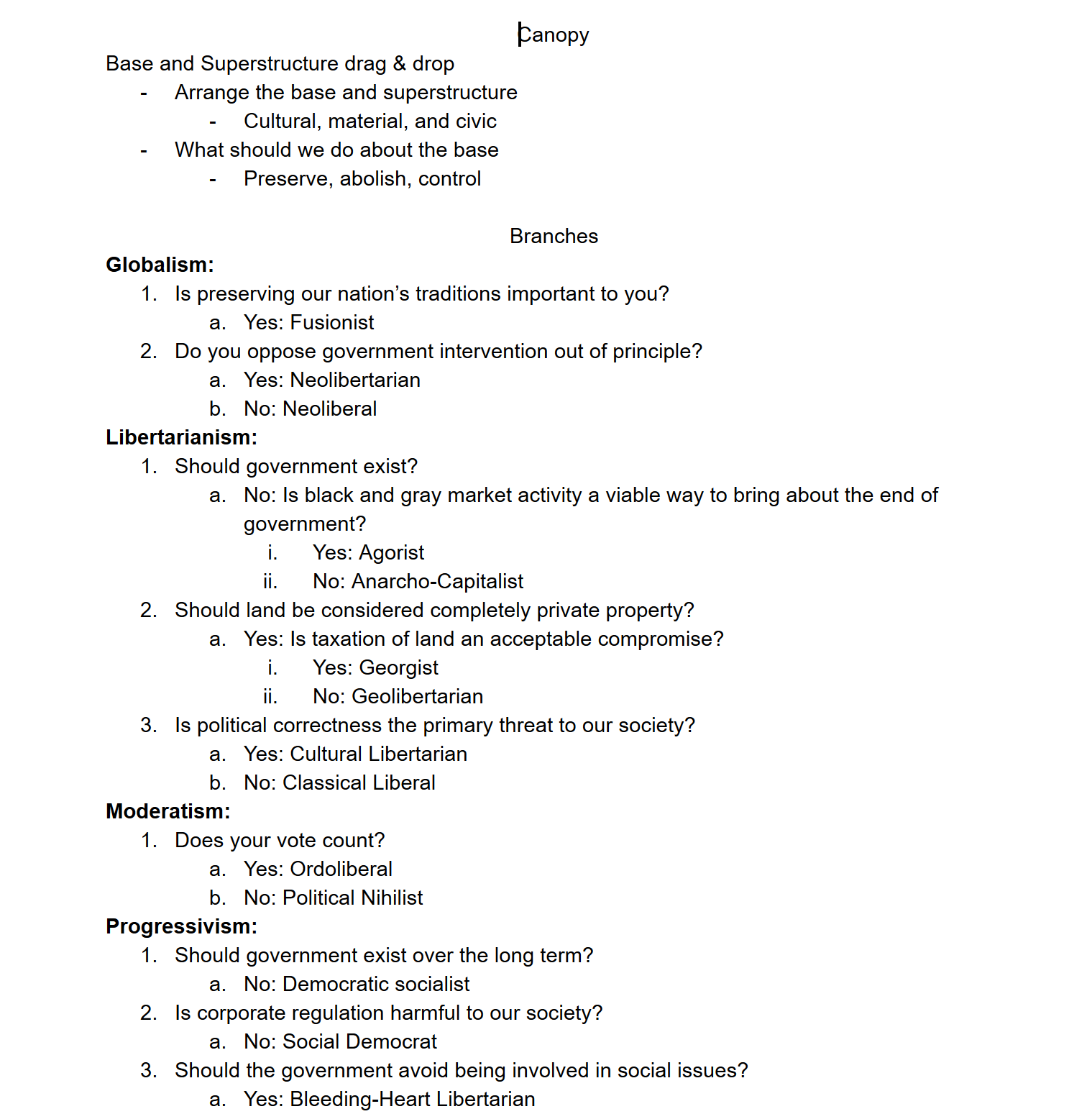
December 2018
I eventually got around to setting up the site’s CSS, using the aesthetic theme of another website I was running as a model. Things felt a lot more organized now that I could visualize the direction the test was taking and I had a clearer idea of how I wanted to execute the project.
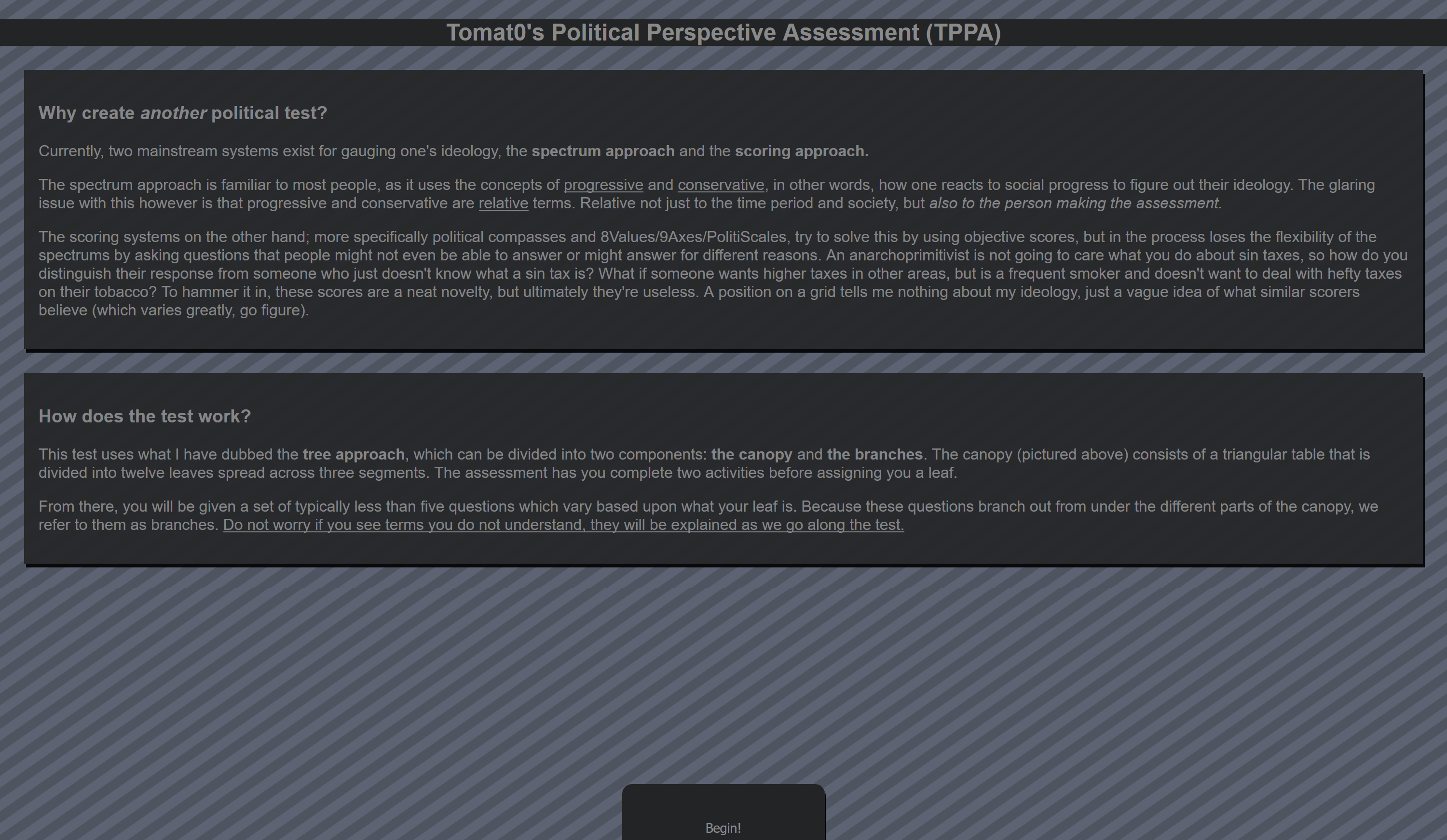
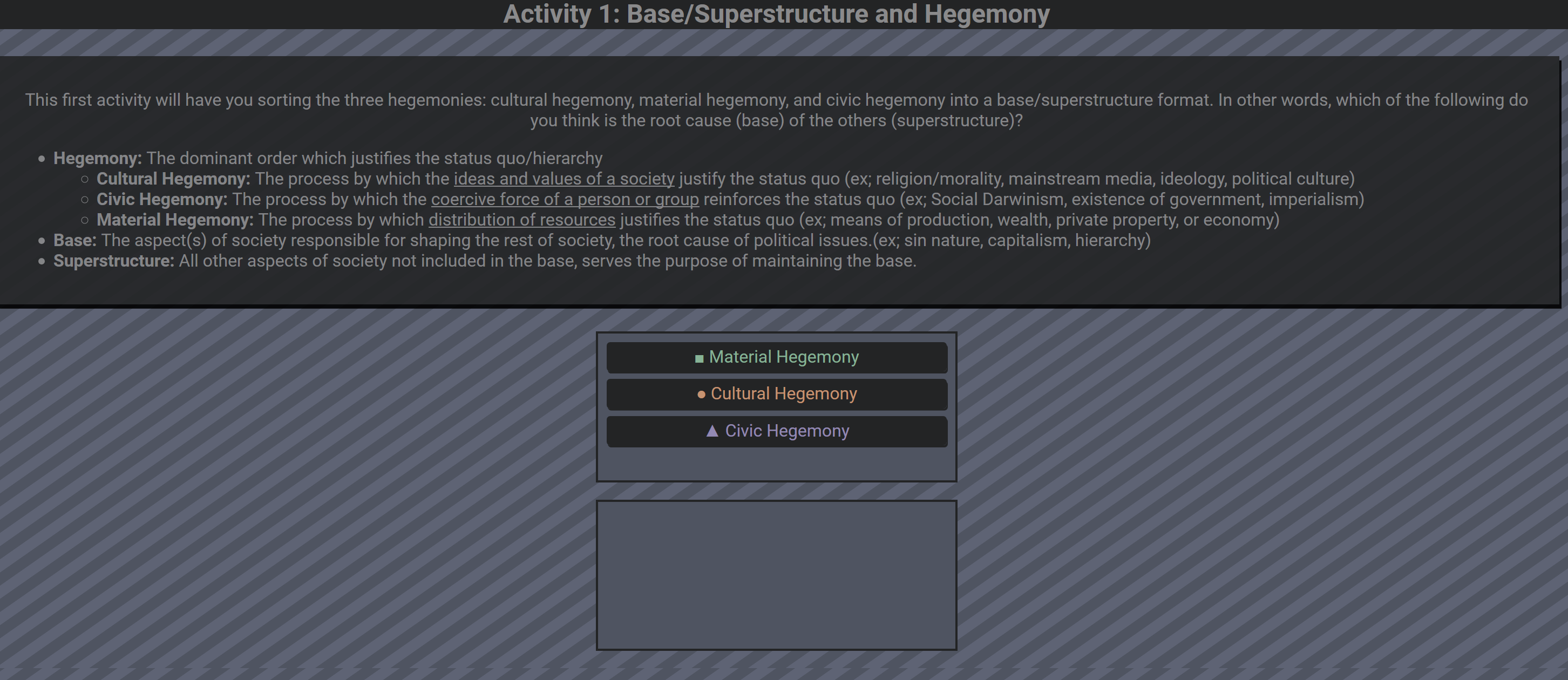
April 2019
After an extended hiatus, I returned back to work on the site, finally creating the page for the second question and changing up the color palette.
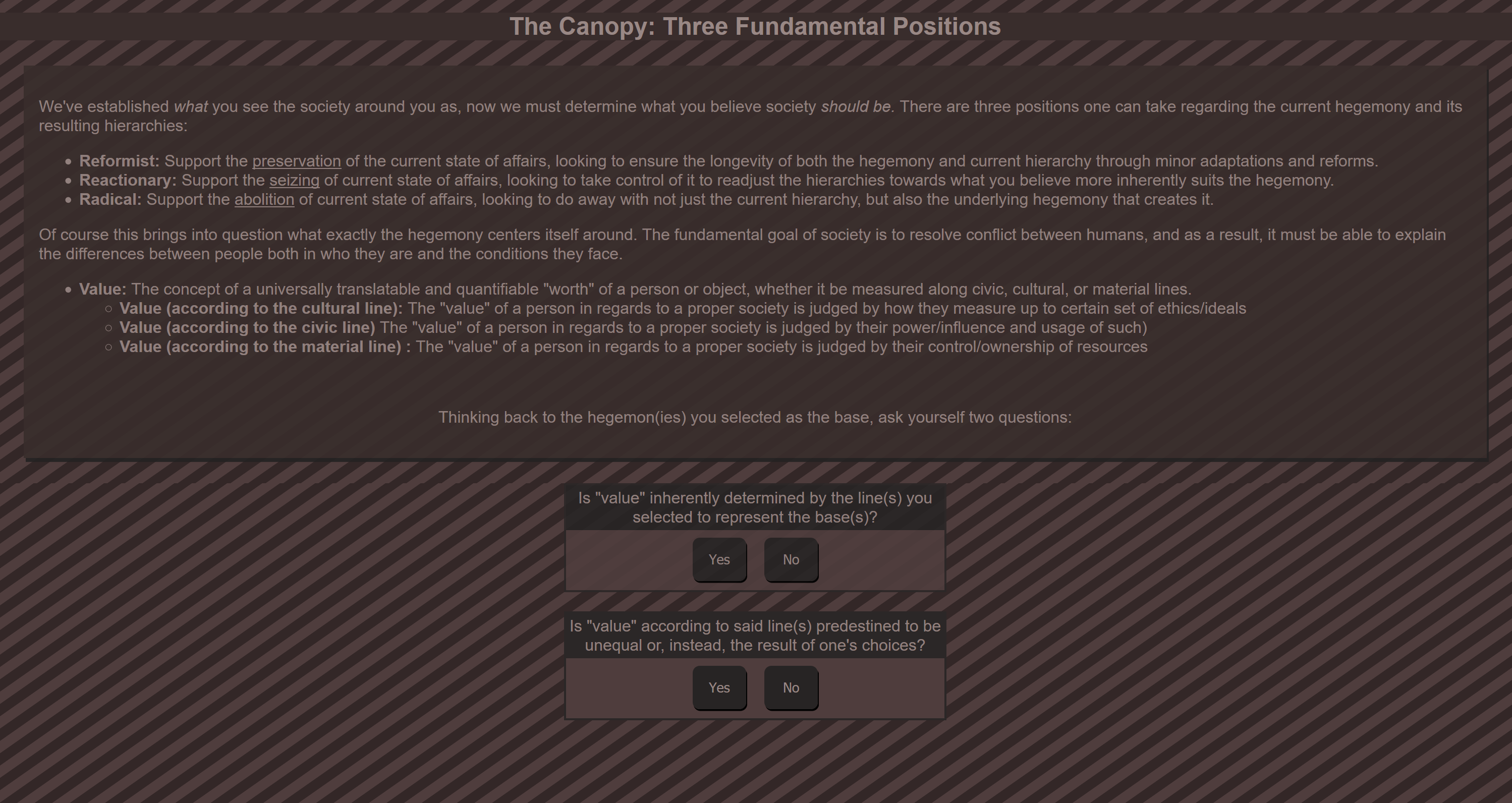
June 2019
With the site coming further underway, and the SVG going through its countless revisions, I decided to shift my strategy. If I were to work on the questions first and make the results later, any changes I’d make to the results would force me to rework the questions that are dependent on them too.
I decided to go back and rework the branches themselves, since a lot of them were mostly either filler or too similar to others. I took notes until I settled on a balance of around two to three per leaf. This greatly helped me narrow things down and get a better understanding of exactly what I was adding to the test instead of just taking everything I could find off of Wikipedia.
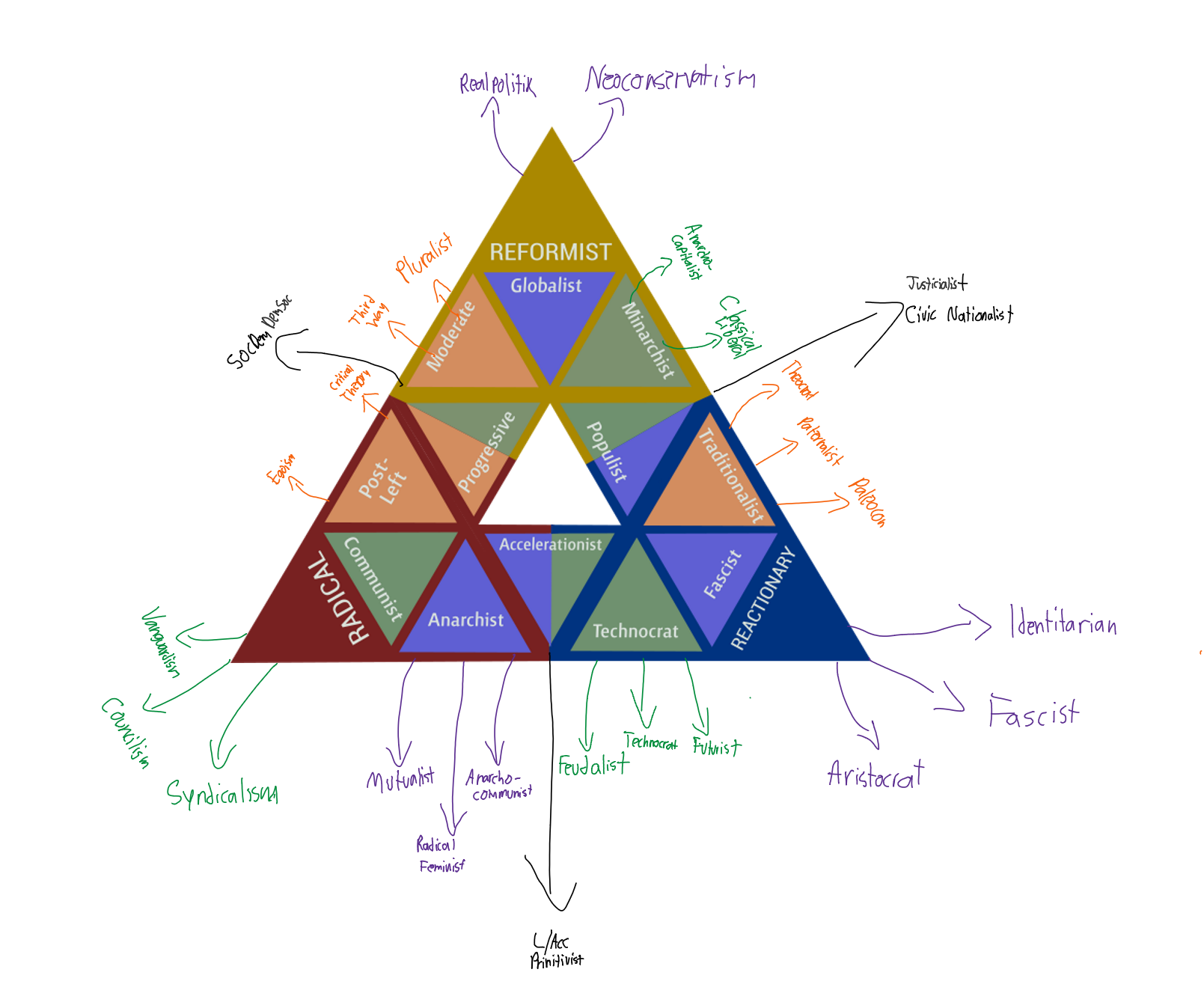
July 2019
Now that I had narrowed down the branches and started to get a more consistent idea of my plan for the leaves, I began my strategy of working backwards. In order to better complement the quiz portion and make the whole project more accessible to people newer to political theory, I’d shape the info/results pages for the leaves and branches around the goal of giving people a primer on the various ideologies that are being discussed in the test.
My plan was to provide a definition for each one, some key facts to clear misconceptions, and also a list of historical figures who would fall under each category.
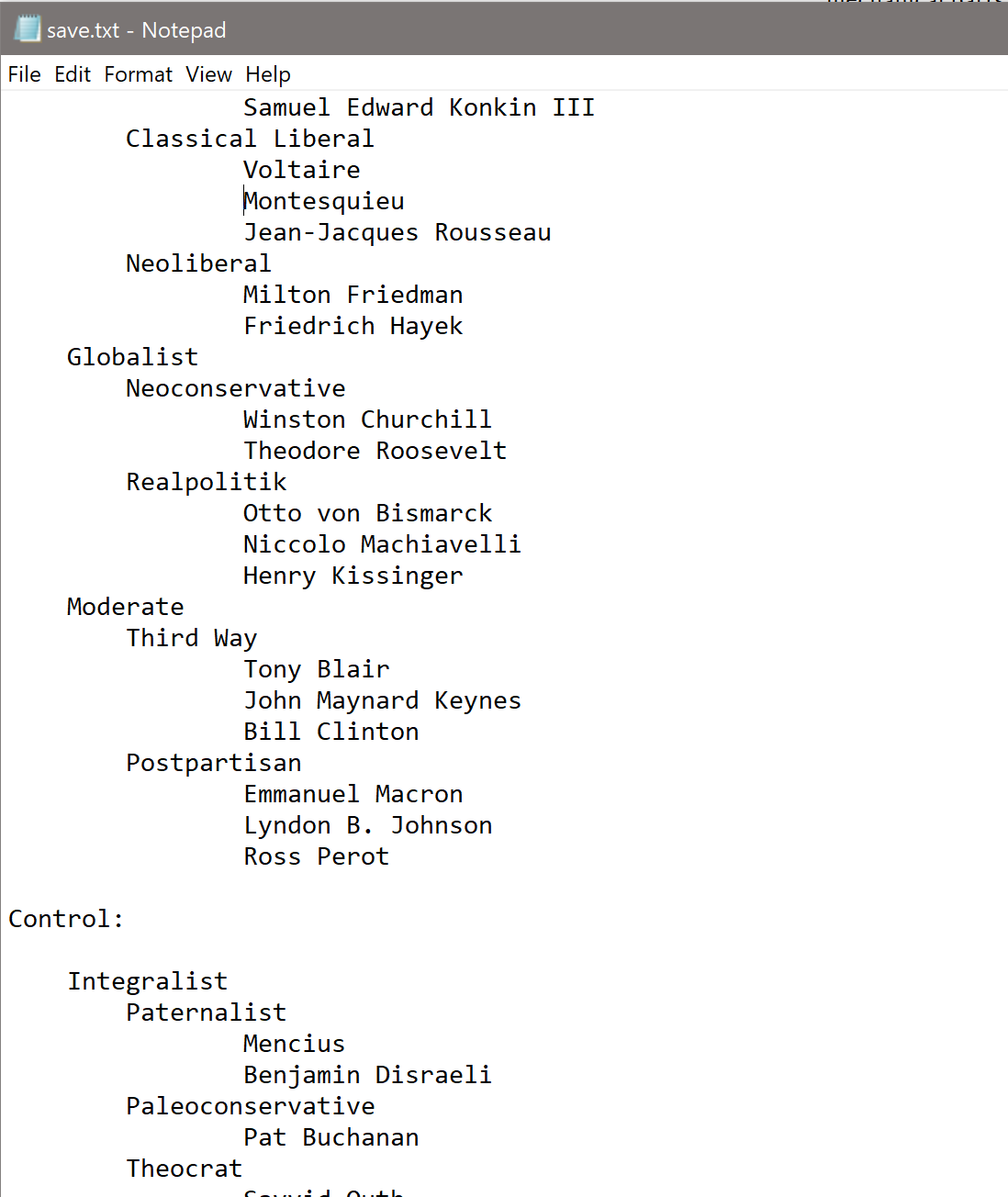
August 2019
By this point, the project had been moved to GitLab for a few months. It was around this time I began taking my planning from July and began on the execution. The list of historical figures got scrapped: the difficulty of accurately pigeonholing was not worth the effort when a list of names didn’t exactly serve as a useful reference for those who weren’t already familiar with their work.
The development of the “primer” aspects of the leaf and branch pages involved the following:
- The aforementioned definitions and key facts were kept, as they still served a use.
- An FAQ page was added, it explains the process of the test, and acts as a “wiki” of sorts for the whole site.
- Each leaf was given a key term that showed what concept is at the core of their worldview, and also a few statements explaining the leaf’s relation to the previously answered questions.
- Reading lists are given for both leaves and branches, with the consultation of various people across the political landscape to ensure they are both introductory and also comprehensive. I put priority towards primary sources and texts that covered historiography, theory, and action.

September 2019
As per the feedback I was receiving, I went ahead and made cosmetic changes to the site. Icons were added for each leaf, the triangle was completely recolored with contrast toned down, and the site was minimized, with unnecessary patterns/effects removed and the theme reduced to three main colors.
I started by sketching the icons, then eventually found similiar ones online that matched what I was going for. I edited them to match the color scheme of the site, then imported them in.
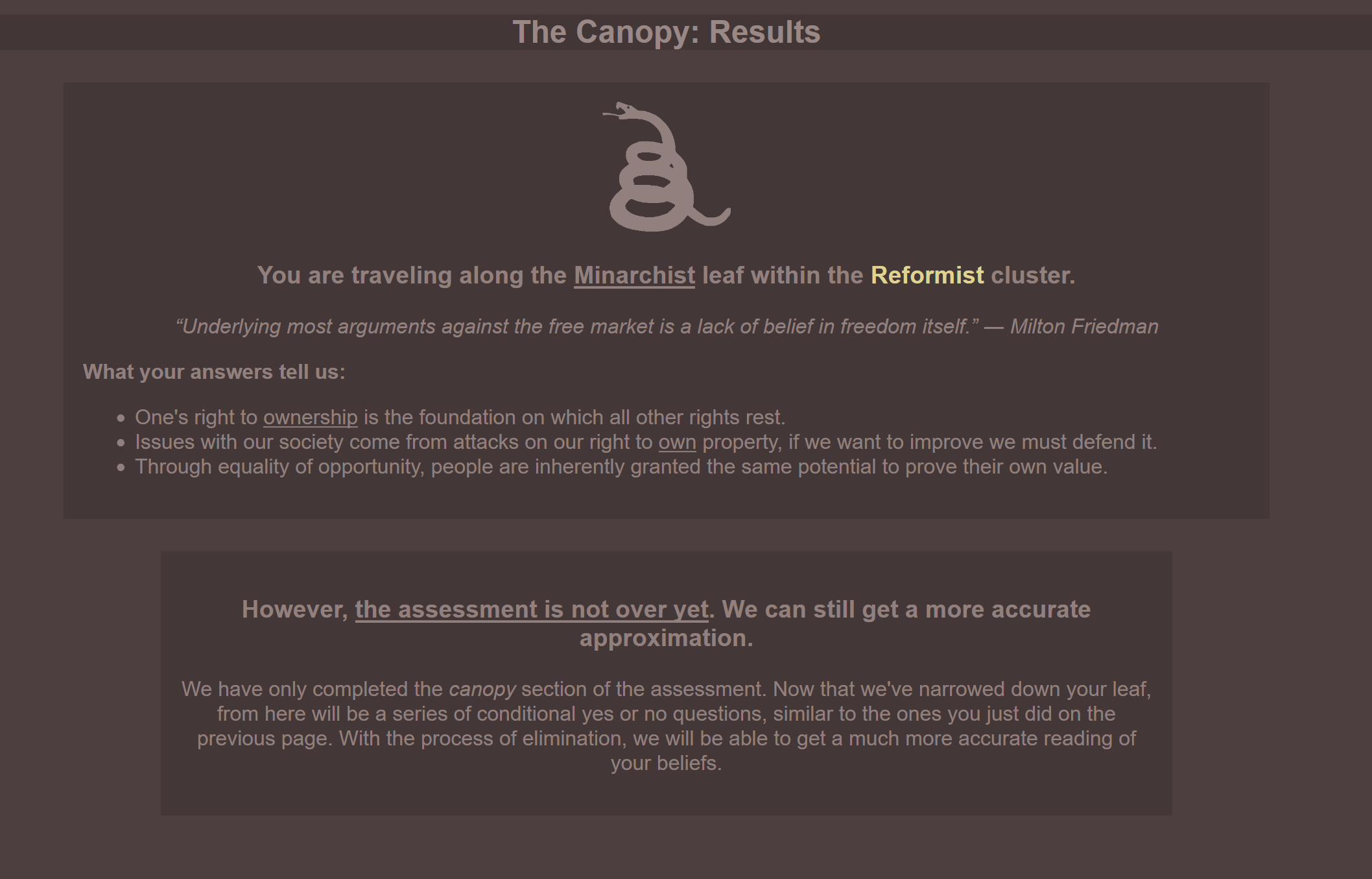
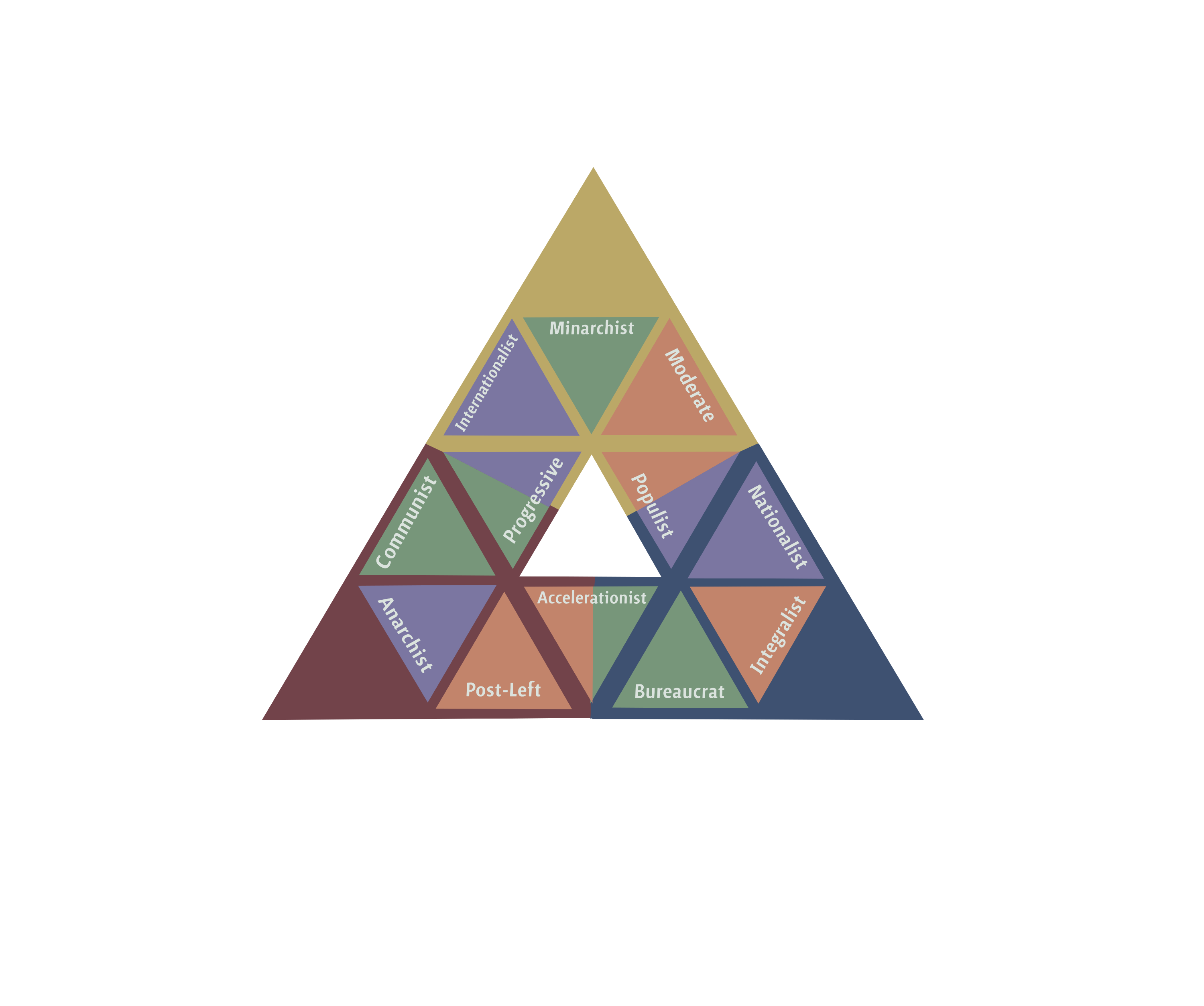
October 2019
A large chunk of October was dedicated to finishing up the bio pages for the various branches. As of the 31st of October, 19 out of the 34 pages have been completed, with 87 books being linked as further reading material. Some of these books were more difficult to get than others, especially the Futurist Cookbook, which I am still working on getting together.
The Futurist Cookbook by F.T. Marinetti is an incredibly fascinating work, with one caveat. Digital copies are region-locked to the United Kingdom. So instead, I have taken to manually transcribing a physical copy I found at my library using LaTeX. Here’s a preview of what I’ve done so far: 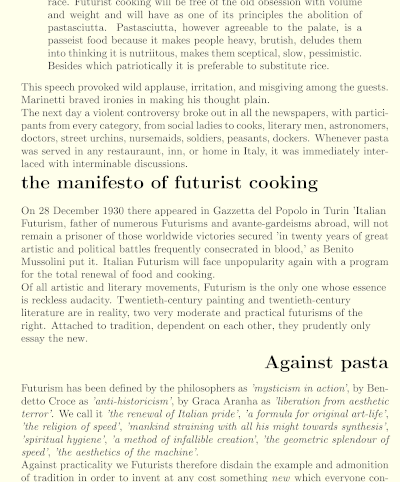
On top of that I’ve been experimenting with a few ways to improve the bio pages.
One of them being a “metadata” block for each book, detailing important information such as length and difficulty: 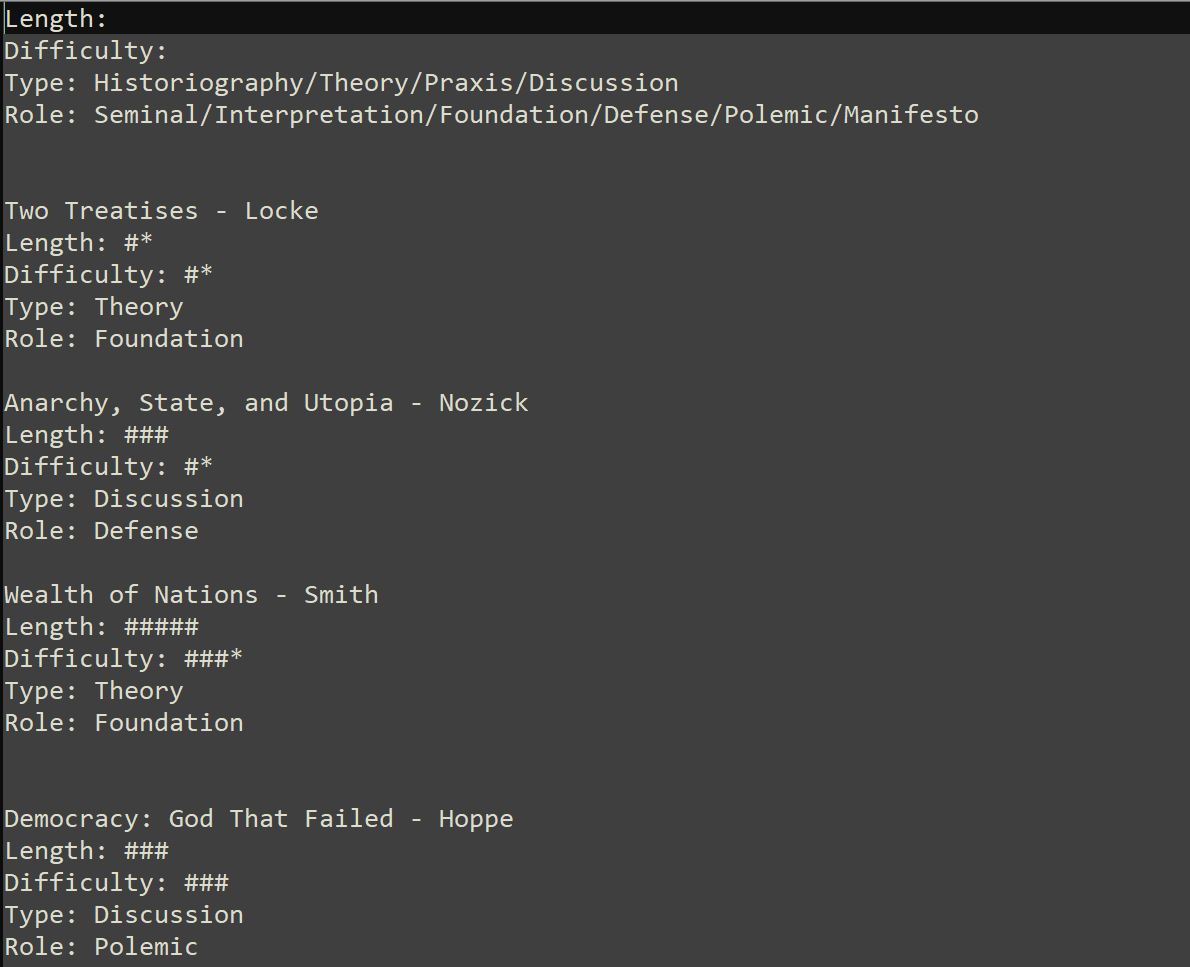
Another one was having specific, traceable schools of thought mentioned on the branches with a short definition, to give people something to connect to. Not sure if I’m going to keep this idea or not, but it’s still a possibility for the time being.

November 2019
By the end of November, I had finished up all the pages in the Radical and the Reformist clusters. A lot of this month was dedicated to cleaning up the various reading materials and grinding out a lot more of the boring stuff as we approach the end of the results pages. As for transcribing The Futurist Cookbook, currently I have completed a third of the whole thing.
Behind the scenes I have been consulting others for advice and beginning work on preparing for manually testing this with focus groups. I’ll most likely begin putting this into action when the results are more concretely laid out.
Blogger and software engineer. I write on tech, politics, and theology.

